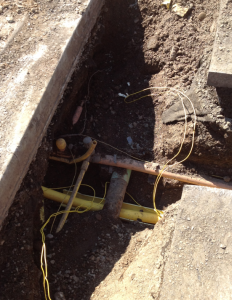June 2013, Vol. 240, No. 6
Features
Avista Ready To Ramp Up Infrastructure Replacement Program

Headquartered in Spokane, WA with a service area of more than 30,000 square miles in eastern Washington, northern Idaho and parts of southern and eastern Oregon, Avista Utilities is embarking on a 20-year program to systematically replace 714 miles of plastic main piping and install transition tubing at the identified steel tees at a cost of about $10 million a year. The investor-owned utility serves about 323,000 natural gas customers and another 158,000 electric customers.
In this interview, Mike Faulkenberry, a 20-year veteran with Avista and its director of Natural Gas, tells Pipeline & Gas Journal readers about the company’s “reliability forecasting” for replacing aging pipe. He also touches on some of the scheduling considerations – such as pavement moratoriums for newly paved roads – that must be considered along the way. He adds that Avista expects the lag time between its infrastructure improvements and cost recovery to show improvement, once the program is fully ramped up.

P&GJ: Can you tell us about Avista’s infrastructure replacement program? What are the initial priorities? When was most of your system’s pipeline laid?
Faulkenberry: Most of Avista’s natural gas pipeline was laid in the 1950s and 1960s. Our oldest pipe was installed in the 1930s.
Avista manages its infrastructure replacement using “reliability forecasting.” Avista has an asset management team that performs reliability forecasting of our aging infrastructure, utilizing Availability Workbench™ software. Forecasting is performed utilizing historical operating – DIMP (distribution integrity management program) data, estimated data from subject matter where historical data isn’t available or is insufficient, maintenance-cost and risk-cost data. With this input, probability curves of expected failure rates over time are developed that enable us to make replacement decisions.
Initial priorities for Avista were to study its pipeline systems. However, we have also studied our service regulators and automated meter-reading devices.
P&GJ: What is the cost of the overall replacement program? Is the cost increasing from year to year?
Faulkenberry: Reliability forecasting on the gas side of Avista’s business has been ongoing for about three years now. Studies of our steel pipeline systems did not suggest a need for a targeted replacement program. However, studies of our polyethylene pipeline systems did suggest a need to begin a replacement program.
Our studies indicated two areas of reliability concerns associated with certain sizes and vintages of polyethylene pipe. For this particular piping main sizes, 1 1/4-inch through 4-inch, manufactured prior to 1984, Avista has begun experiencing increased leaks. As a result of our studies, we have begun a 20-year replacement program for 714 miles of this plastic main piping that meets these parameters.
We also have observed increasing failure rates of plastic service tubing at connection points to steel service tees. The increased failures appear to not be dependent on tubing age, and are attributed to stress concentrations at the steel to PE interface. Avista has identified approximately 16,000 service tees with steel to plastic tubing transitions. Avista is also beginning replacement of short 1- to 2-foot sections of this particular service tubing with modern day service tubing at the steel service tees for each of these 16,000 services.
The overall program cost to replace the plastic main and install transition tubing at the identified steel tees is currently estimated to cost $200 million. We anticipate spending approximately $10 million per year in this effort.
P&GJ: From a purely logistical standpoint, what are the biggest hurdles to overcome in an ongoing infrastructure replacement project of this type? What technologies do you find most useful in your construction and pipe replacement program?
Faulkenberry: While the Availability Workbench™ software has prioritized the replacement, other considerations must be made to perform the replacement in an efficient manner. The facilities targeted for replacement are interspersed throughout our system, so we can’t just replace the entire pipe in a given area. We have to be strategic about how we approach the replacements.

For the main replacement, we are focusing on the highest prioritized pipe and also the highest concentrations of the targeted pipe. Other considerations such as pavement moratoriums for freshly paved roads create a scheduling challenge. The steel service tee transition tubing replacement is somewhat less strategic in its replacement schedule as it involves digging bell holes at each tee.
Whenever possible we are trying to align replacement projects with other city and county construction projects so that we can minimize costs and interruptions to our customers. We are exploring increased use of key-hole technology and perhaps use of pipe-splitting technologies to aid us in construction.
Being located in the Northwest, much of Avista’s service experiences winter weather that does not permit year round construction. Seasonal work restrictions, along with increased industry need for contractor workforces, have created additional challenges in attracting the workforce needed for our pipeline replacement program.
P&GJ: How are you prioritizing your O&M budget? Perhaps through improved record keeping?
Faulkenberry: We have increased leak surveying of the main and steel service tees with plastic tubing piping prior to their replacement. These are on an annual survey schedule now. This increased leak survey frequency and any leaks that are identified will increase our O&M costs in the near term, but we believe these costs are prudent. As we get further into the replacement program, we expect to reduce these costs as leaks will decrease.
We are looking for ways to improve our as-built processes for the new pipe we are installing. Our current process is a paper process that is entered by editors into our GIS mapping system. A project is underway to develop a system to read bar coding on the piping and fittings after they are installed in the trench and to transmit them via mobility software into our GIS system.
P&GJ: Will the majority of your work involve new construction or replacement activity? Are you doing most of the construction work yourself or contracting it out?
Faulkenberry: The main piping project will be new construction alongside the existing main that will be abandoned in place. As we are not replacing service tubing – services will be transferred over and tied into the new main. Avista plans to contract most of this work.
P&GJ: How far along are you with the program? Is the work on schedule?
Faulkenberry: Avista began the main replacement project in 2012. So far, our schedule is on track with our original plan. While we forecast the project to take approximately 20 years and cost approximately $200 million to complete, it is taking time to ramp up to an annual spend of approximately $10 million per year. We spent $4.6 million in 2012 and our plan is to spend $8.3 million in 2013. We are gaining efficiencies with each project and integrating what we learn into continuous process improvement for the 20-year program.
P&GJ: What, if anything, is needed to allow providers to recover costs associated with pipeline-replacement programs on a timely basis?
Faulkenberry: Our expenditures on pipe replacement are governed by our cost-risk assessment methodology and are not driven by matters of timely cost recovery. That said, Avista actively pursues timely recovery of all its utility investments in each of its state jurisdictions. The Washington UTC has recently created an expedited cost-recovery mechanism for pipeline replacement programs.
In Idaho and Oregon, the PUCs have been willing to include some forward capital costs in their “test year” evaluations of utility costs. Our regulators expect us to replace failing infrastructures in a timely manner, and they place the accountability associated with prudently managing higher-risk infrastructure squarely on the utility. In our experience, they are willing to look for ways to expedite cost recovery, provided our plans are solid.
P&GJ: Will the LDC start seeing some improvement in the lag between when the dollars are spent for infrastructure improvements and when you can recover these expenses?
Faulkenberry: Our pipeline replacement program is just beginning, but Avista expects to see improvements in the time between improvements and when these costs are recovered.
P&GJ: With the growth of natural gas, are you serving more customers (residential, commercial, industrial), and are you having to expand to service them?
Faulkenberry: The economy and residential growth has not recovered in our service territory. Our growth the last few years has been at about 1% and likely will be similar again this year.

P&GJ: Your AGA presentation referenced company assets such as coated steel mains, some of which dated back to the 1930s. Are there special problems associated with replacing infrastructure that old?
Faulkenberry: While our reliability forecasting model has not suggested a need for targeted replacement of our steel assets, we do replace older steel as opportunities arise. Much of our main that dated back to the 1930s has been replaced. The majority of our existing steel main is newer than 1955 installation. We are not experiencing any special problems associated with this pipe replacement. Much of the steel facilities are replaced as part of city and county road projects or by request by others.
P&GJ: When was your replacement program initiated? How many miles of aging steel and cast iron mains has Avista replaced in the past five years?
Faulkenberry: As mentioned earlier, Avista’s pipeline replacement program is targeted at specific plastic main piping and tubing. Avista’s steel pipelines are not specifically targeted for replacement based on its reliability forecasting. Avista has replaced 114 miles of steel in the last 5 years. Avista has never had cast iron in its pipeline system.
P&GJ: In closing, how did you get into the business?
Faulkenberry: I started in the utility business in 1982 after graduating from college with a mechanical engineering degree at the University of California at Davis. I initially worked for Pacific Gas and Electric Company for 10 years, primarily focusing on pipeline design and operations. In 1992, I began working at Avista Utilities (then Washington Water Power) and have been employed here for more than 20 years mostly in gas engineering related roles.
By Michael Reed, Managing Editor





Comments